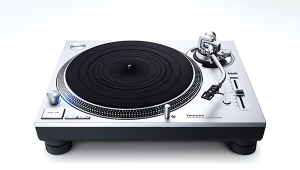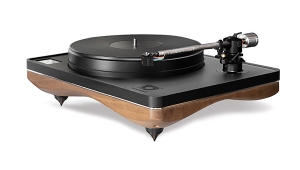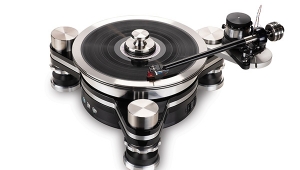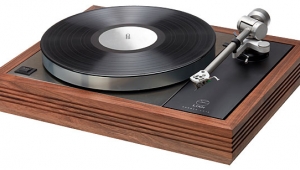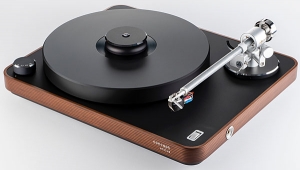| Columns Retired Columns & Blogs |
Kuzma Stabi XL turntable & Air Line tonearm Page 2
My experiment was to use the Stabi XL/Air Line and Caliburn/Cobra, both with the same Lyra Titan i cartridge and Manley Steelhead phono preamp, to record (with an Alesis MasterLink) a CD-R of difficult-to-reproduce musical passages (solo piano, violin, orchestral crescendos, female vocals), all of which had been cut near the lead-out groove areas of various LPs—and then play the two recordings of the same passage back to back to see if discerning audiophiles could tell which had been played by the pivoted arm, which by the tangential tracker.
When I'd conducted an earlier version of this experiment with different cartridges (a Transfiguration Orpheus in the Cobra, the Titan i in the Air Line), no listener, experienced or otherwise, could tell which was the pivoted arm and which the tangential. Still, less experienced listeners (shoppers at a dealer demo) gravitated toward the brighter, noisier sound of the Titan–Air Line–Stabi, while the more experienced sales staff at the store, and a roomful of audiophiles at an Audiophile Society meeting, heard past that enticing brightness to the truly greater detail and resolution of the Cobra-Transfiguration-Caliburn's subtler, more self-effacing sound. All agreed that the latter was also notably quieter, but the difference in cartridges made any further conclusions suspect.
Both listening sessions concluded the same way: Someone said, "But of course, timbrally, these are so different that it's not a fair test. You need to do it again using the same cartridge."
I did, paying very careful attention to setup and VTA, and took the resulting CD-R to the 2007 Consumer Electronics Show. Wherever I played it, it created a sensation. That they were hearing the same cartridge in both recordings of the same material left all who heard them incredulous, so timbrally different were the sounds. (When I got home from CES, I double-checked all setup parameters, including the air pressure reaching the Air Line's air bearing. It was set correctly.)
Again, audible distortion was never an issue on either recording, demonstrating once again that a properly designed, executed, and set-up pivoted tonearm need not produce audible tracking-error distortion. And again, one setup produced a brighter, more "hi-fi like" presentation that contained more apparent detail while yielding far less genuine detail—the latter was masked by a hard, icy overlay that excited the ears of less experienced listeners. These differences weren't subtle, and were similar to the ones heard on the earlier test using different cartridges.
When, long before I wrote about the Air Line, I reviewed the Rockport Series 6000 air-bearing tonearm, (May 1996, Vol.19 No.5), Rockport's Andy Payor made a big issue of the need to reduce the high air pressure in the bearing's "work zone" to ambient air pressure by the time it reaches the annular gap. If this is not accomplished precisely, he insisted, the resulting turbulence produces a high-frequency resonance at the gap that might be less critical for machine tooling (which air bearings were originally designed for) than for tonearms.
Rockport uses what's called a "groove-compensated" air bearing to accomplish this pressure normalization, which Payor and the company that makes their bearing claim provides more stable performance at the annular gap. The Kuzma Air Line uses a porous wall bearing that operates at a higher pressure. Might turbulence at the Air Line's annular gap have had something to do with what I heard? I don't know. I'm neither a designer of air bearings nor a mechanical engineer—but Franc Kuzma is both.
I do know what I and others heard. Whatever the cause, the Stabi XL's superior performance and retrieval of detail, compared to those of the Simon Yorke Series 7 turntable with which I reviewed the Air Line back in 2004, made this edgy overlay quite audible; the less revealing, warmer-sounding Yorke S7 masked it.
This is not to say that the Kuzma Air Line isn't a fantastic product. It's still among the finest tonearms I've heard. However, it offered greater synergy with a less analytical cartridge than the Titan i. When I returned from CES, I installed the Air Tight PC-1 cartridge, which, while detailed and highly resolving, provides a slightly warmer picture than the Titan. That combination was stunning.
I then exchanged arm towers, putting the Graham Phantom arm on the adjustable tower and the Air Line on the fixed tower. I installed the Titan i in the Graham, and did a great deal of listening to it, as well as to the Air Line with the Air Tight PC-1. The one complaint I hear about the Graham Phantom is that it doesn't sound as "open" as some other arms. Bob Graham's position is that you can't really overdamp a tonearm (he's not talking about damping the arm/cartridge resonant frequency), and that "brighter" arms have additive resonances.
The combination of Titan i, Graham Phantom, and Kuzma Stabi XL was nearly ideal, combining all of the 'table's strengths already discussed, and adding the Phantom's rock-solid bottom end (a huge improvement over the Graham 2.2!) and smooth, silky, yet detailed top end. In the right situation, the Titan i remains among the top few cartridges I've heard. This was the right situation.
Conclusion
Franc Kuzma's Stabi XL is a work of mechanical and physical art. It is among the handful of turntables I consider to be the best currently available, and a good value at $18,000. It maintained perfect speed throughout the months of the review period, and provided an ultrastable, mass-loaded platform for any good tonearm, provided the turntable was placed on an equally stable platform. (I'm convinced that the Stabi XL's rock-solid, open, clean, and effervescent sound will depend to some degree on the platform on which it's placed, especially since its arm tower, platter, and motors will all need to share that platform.) If you crave the comfort of "warmth," the Stabi XL might not be for you. But remember: While you can add some warmth with an appropriate choice of cartridge, a brightly lit cartridge can never compensate for a soft-sounding turntable.
If your system already has subterranean bass extension, the Stabi XL will deliver all of the low-frequency information etched into the grooves of your LPs, minus the overhang, bloat, and time smearing that lesser turntables would add. If you like cleanly rendered high-frequency transients and overall clarity and transparency, the Stabi XL offers those as well. It requires the best associated gear, and will ruthlessly reveal any shortcomings elsewhere in the signal chain. If the Stabi XL has any sonic character of its own, it would be an overaggressive attack, a truncated sustain, and an inability to plumb the lowest depths of the noise floor—but because a turntable can't "play" by itself, but operates as part of a system that also includes the cartridge, tonearm, and platform, it's difficult to be sure that those characteristics are functions of the 'table itself (though I suspect the Stabi XL tends in those directions).
However, as good as the Stabi XL is—and it's really good—the four-times-as-expensive Continuum Audio Labs Caliburn is still in a class of its own. You can take that to the bank.
As for my experience with the Kuzma Air Line tonearm, I am at a loss to explain what I—and others—heard. Perhaps this review sample, a veteran of numerous audio shows and reviews (it could even be the same one I reviewed in 2004), has a problem. However, when used with a complementary cartridge, the Air Line is still among the finest tonearms I've encountered, and its mechanical performance was faultless and utterly dependable.
- Log in or register to post comments
